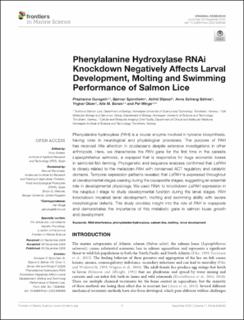Phenylalanine Hydroxylase RNAi Knockdown Negatively Affects Larval Development, Molting and Swimming Performance of Salmon Lice
Guragain, Prashanna; Sporsheim, Bjørnar; Skjesol, Astrid; Båtnes, Anna Solvang; Olsen, Yngvar; Bones, Atle M.; Winge, Per
Peer reviewed, Journal article
Published version

Åpne
Permanent lenke
https://hdl.handle.net/11250/2712012Utgivelsesdato
2020Metadata
Vis full innførselSamlinger
- Institutt for biologi [2514]
- Institutt for klinisk og molekylær medisin [3426]
- Publikasjoner fra CRIStin - NTNU [37221]
Originalversjon
Frontiers in Marine Science. 2020, 7:608463, . https://doi.org/10.3389/fmars.2020.608463Sammendrag
Phenylalanine hydroxylase (PAH) is a crucial enzyme involved in tyrosine biosynthesis, having roles in neurological and physiological processes. The purpose of PAH has received little attention in crustaceans despite extensive investigations in other arthropods. Here, we characterize the PAH gene for the first time in the parasite Lepeophtheirus salmonis, a copepod that is responsible for huge economic losses in salmonid fish farming. Phylogenetic and sequence analyses confirmed that LsPAH is closely related to the metazoan PAH with conserved ACT regulatory and catalytic domains. Temporal expression patterns revealed that LsPAH is expressed throughout all developmental stages peaking during the copepodite stages, suggesting an essential role in developmental physiology. We used RNAi to knockdown LsPAH expression in the nauplius I stage to study developmental function during the larval stages. PAH knockdown impaired larval development, molting and swimming ability with severe morphological defects. This study provides insight into the role of PAH in copepods and demonstrates the importance of this metabolic gene in salmon louse growth and development.
